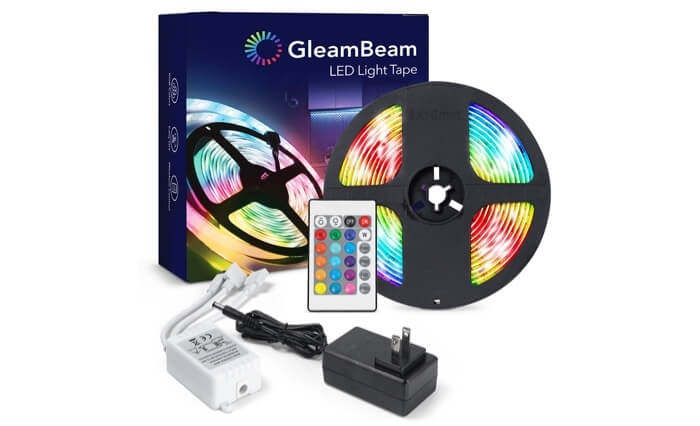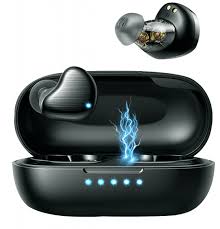For a long time, many projectors have been sized in such a way that it requires at least the use of both hands and arms to lift and transport. They were not quite suitable to be used in homes or even small rooms.
In the time past, projectors were usually available in classrooms, lecture halls, and even seminar halls. Also, a cellphone user did not have the opportunity to play with a projector, only those with either a desktop or laptop could project what they wanted into a bigger screen.
However, it has now become something of a staple to have users with smartphones that may want to have a big-screen experience. This has led to the development of the MaserMi LED projector. The MaserMi LED projector is not a video projector but merely a color projector.
It has become more than a sufficient solution if you want to amp your room’s ambiance for getting together nights and other fun events.
This has made a lot of users breathe a sigh of relief at the reality of not needing to invest in expensive lighting equipment which is, frankly speaking, bulky and too much work.
It is a versatile, lightweight, and compactly designed device containing a range of patterns available to choose from. It is a portable device you can take everywhere that as a USB port.
The Masermi LED Projector is also built with security and safety measures in mind. This makes it suitable for use by children in terms of the durable material it is produced with and the apparent absence of small parts that can easily be swallowed.
The MaserMi projector is manufactured using good quality components and it gives an amazingly good performance for a device of its size. This review takes a deep dive into the product and the technology behind it to see if it is worth the hype.
CLICK HERE TO>>>BUY NOW<<<

LED Technology Explained
LED technology is a technology that has revolutionized the screen and video projection industry.
LED technology is widely used as a replacement for cathode ray tubes and laser beams. The LEDs in a typical LED projector use a process known as electroluminescence for light projection.
Electroluminescence is an optical and electrical phenomenon such that a given material or body proceeds to emit light while responding to the passage of an electric current or responding to a strong electric field.
This is distinct from black body light emission which results from the heat also called incandescence, a chemical reaction called chemiluminescence, sound
emission also called sonoluminescence, or other mechanical action referred to as mechanoluminescence.
Electroluminescence, more specifically speaking, is the result of radiative recombination of electrons & holes in a material that is often and usually a semiconductor.
The now excited electrons release their energy as photons which is in the form of light energy.
Before the recombination process of the electrons and holes, electrons and holes may either be separated by doping the material to form a p-n junction in semiconductor electroluminescent devices with examples such as light-emitting diodes or through excitation by the impact of high-energy electrons accelerated by a strong electric field as with the phosphors in electroluminescent displays.
It has been recently shown according to certain studies, that as a solar cell improves its light-to-electricity efficiency (as a result of improved open-circuit voltage), it will also improve its electricity-to-light (EL) efficiency.
Examples of the range of EL material include:
- Powdered zinc sulfide is doped with copper which produces greenish light or silver which produces bright blue light.
- Thin-film zinc sulfide is doped with manganese which produces orange-red color.
- Naturally occurring blue diamond, which includes a trace of boron which then acts as a dopant.
- Semiconductors containing Group III and Group V elements, such as indium phosphide, gallium arsenide, and gallium nitride which is a light-emitting diode.
- A number of organic semiconductors
The most common and widely available electroluminescent devices are made up of either powder which is primarily used in lighting-based applications or thin films which are utilized for information and signage displays.
Simply put, to describe electroluminescence; Electricity passes through a wire placed in a bulb, making it heat up to the point that it glows.
LED projectors have been around since the early sixties by General Electric Company. They became commercially available in the late sixties and were red in color.
They were invented with the intention to replace the incandescent indicators and were also used in seven-segment displays. They were first used in very expensive devices like laboratory equipment and certain electronic test equipment.
It was later then adapted into television sets, radios, telephones, calculating devices, and very recently, wristwatches. These early LEDs which were primarily red in color, as established earlier could only be used as indicator lights because the output of the light was not bright enough to illuminate an area.
Much later, further development gave birth to a range of colors it could reflect and thus, enabled its application in appliances, devices, and equipment.
The LED material and its technology became even much more advanced and as a result, the developers were able to increase the output of light as clearly observed in the MaserMi…
There are two kinds of LED panels which include;
l Conventional LED panel
l Surface Mounted Device panel
The Conventional LED panel used discrete LEDs also known as individually mounted LEDs. To form a full-color pixel, a cluster of green, red, and blue color diodes are driven together. The pixels are evenly spaced and are measured from center to center to get an absolute pixel resolution.
The Surface Mounted Device LED panel is the technology that is widely adopted in this contemporary LED market. The pixel in the Surface Mounted Device has red, green, and blue diodes which are mounted on a chipset and in turn mounted on the driver pc board.
CLICK HERE TO>>>BUY NOW<<<

What is the MaserMi LED Projector?
MaserMi is a USB compatible, LED night light projector with the ability to project night lights onto any surface such as the wall of a room or even the roof. This is a cylindrically shaped LED light device. It is very portable as you can close it completely with the palm of your hand.
The projector comes with a small, complete, flexible USB cord attached to it. This makes it able to rotate up to 360-degrees. It currently comes with two color models including red and purple. Some reviews have shown that some customers purchase both color models to combine them for a “double dazzle” effect.
The projector is fitted with a rotating tip that passes the provided light through filters and this gives the starry, patterned night sky effect. It also gives the effect created by a disco ball lamp.
How the MaserMi Works?
Simply put, the MaserMi LED projector works via any (and I mean any) USB port connection. Because of its portability, you just need access to a USB port and there you go, you have your mini-disco party. The cord attaches to any USB device including a laptop, phone, car USB port, and a power bank.
Technology Behind the MaserMi
The MaserMi projector is based on the LED(Light Emitting Diode) technology as earlier mentioned. LED is a semiconductor light source that emits light through the flow of electrons through the semiconductor.
The electrons in the said semiconductor recombine with the electron holes, thereby releasing energy in the form of photons.
For this specific product, the mechanism behind it is based on the fact that the color of light it emits is determined by the energy required for the electrons to cross the bandgap of the semiconductor.
The first LEDs appeared as practical electronic components in the early sixties. They were used as parts of electronic components. These LEDs emitted low-intensity infrared(IR) light and are used in remote control circuits such as those used with a wide variety of popular consumer electronics.
The LEDs manufactured at this time were used as indicator lamps that replaced small incandescent bulbs and were also used in seven-segment displays.
The light emitted from a LED is neither coherent spectrally nor monochromatic. This is unlike many laser lights. The spectrum is sufficiently narrow such that it appears to the human eye as pure color.
Also, the radiation from the LED light is not spatially coherent. As a result, it does not approach the very high brightness which is characteristic of laser beams
Development in recent times has brought about high-output white light LEDs that can be used as indoor or outdoor lighting.
The advantages of this technology include, but not limited to lower energy consumption, longer lifespan, smaller size, and faster switching. LED technology is used in aviation lighting, automotive headlamps, advertising, traffic signals, camera flashes, and medical devices.
LED technology on which the MaserMi is developed uses any of the three base technologies which include;
- a) Digital Light Processing
- b) Liquid Crystal on Silicon
- c) Laser Beam Steering
Digital Light Processing: This relies on a standard white light source and a number of filtering techniques in order to project any content. This white light is directed towards tiny mirrors.
These small mirrors are then placed on chips. These chips in turn direct this light on a screen and then video content is then projected on it. These mirrors have a two-state system: ON and OFF state.
When the system is ON, the brightness of each pixel increases but when the system is OFF, the brightness reduces. These mirrors also act as a control for the color of each pixel. A color wheel is fixed between the white light source and the tiny mirrors.
The color wheel acts as a medium by which small mirrors control the pixels’ color. The wheels are split into primary colors: Red Blue and Yellow. These colors are then mixed and the required color is projected on the designated pixel.
Liquid Crystal on Silicon(LCoS): This technology also employs the use of white light sources to project its content just like the Digital Light Processing technology.
For this method, small LCDs are used to project the video content. The LCDs control the amount of light that is cast on each pixel. The basic designs used in the LCoS technology are Colour Filter LCoS and the Field Sequential LCoS.
The Colour Filter LCoS uses three subpixels to project the desired video. These pixels possess the three primary colors that cast different colors on pixels. The Field Sequential LCoS proceeds to split the input image into three divisions of the three existing primary colors.
Laser Beam Steering(LBS): This LBS technology uses lasers for its operation instead of a white light source. Optical principles are used to coalesce the three primary colored laser beams. The images are formed on the screen because of the presence of laser beams.
The images are scanned rapidly to avoid any occurrence of scan line effects. The disadvantage of this technology is that it is more harmful to the human eye compared to the other two techniques and as such, has a limited range of use especially for things that require the eyes to be protected.
However, the projectors developed from this technique are way smaller in size and consume less power in comparison.

USB LED devices
One of the most popular USB LED devices is a USB LED lamp. The general description of a USB LED lamp goes as follows; It is described as a \small, portable lamp that plugs into the USB port for illumination in dimly lit conditions.
A common adaptation of this technology has been in illuminating a laptop keyboard in situations of poor lighting. Oftentimes, the USB comes as a headlamp and is attached to a long and flexible gooseneck.
This design allows it to be positioned and adjusted according to the consumer’s taste and requirements. The USB LED light is powered by the power it receives from the device it is plugged into. It only functions for as long as the device is on.
In recent contemporary times, personal computers and smartphones have provided consumers with the convenience to work and play, utilizing a variety of settings and lighting conditions which are often less than an optimal level for seeing the keyboard.
External lighting is not often readily available, and when it is, it might bother other people, such as a roommate, a spouse, or a sibling. Some people simply prefer to work, game, or watch movies with the warm glow of the computer screen as the only luminary source. Working in the dark might also be a necessity, such as when giving a work presentation.
In all of these situations, a USB LED light will provide light where it is needed without having to disturb people nearby or the surrounding environment.
USB lights and lamps also come in a variety of models. For instance, lamps with a single LED light might not provide enough lighting for some people.
Individuals looking for a brighter solution can consider acquiring models that often incorporate up to eight or more individual LEDs packed into rows on the headlamp.
A USB LED light with several LEDs might also feature a brightness switch consisting of the low, medium, and high settings corresponding to the number of LEDs in use.
There can be a compromise, however, in choosing a USB LED light with a large headlamp. Certain people can find it difficult to position the head of the lamp so that it illuminates the keyboard without getting in the way of the screen.
Choosing a lamp with a longer gooseneck offers the option of minimizing this problem by providing a greater range of positioning options.
USB LED lights work with any operating system and any USB port that delivers 5-volts of power which include but are not limited to desktops and netbooks as well as laptops. If such a USB light is left plugged into a USB port and the host device is turned off, the light will also turn off automatically.
This shows that the power for the LED light is only from the host device. These lamps are very lightweight and can be easily stored in a computer case.
USB LED lights are available at a variety of prices depending on the preferred model.. A lot of online sellers include sections for customer reviews which can highly be of help when considering and choosing a good model.
The most popular lamps provide sufficient brightness with much longer necks which are flexible enough to be positioned accurately while holding the position well. USB lights are available wherever computer products are sold.
Advantages and Disadvantages of LED technology
Advantages
- LEDs run much cooler than regular bulbs therefore they can be smaller and quieter
- The combination of red, green, and blue LEDs creates a white light that is a better representation of true whites compared to what other bulbs can generate. This makes sure that the LED projectors can reproduce more colors than other projectors.
- The last longer: They last much longer than bulbs and can run for over 20000 hours.
Disadvantages
- They are expensive
How to Use the MaserMi LED Projector
When you get the MaserMi LED projector from their official website, just find a free USB port, plug it in, and voila, your room goes from boring to bubbling in seconds.
The MaserMi comes with multiple patterns that you can switch between. You can switch patterns by simply rotating them. You can adjust the tip to a 360-degree angle from upwards to sideways. You can bend it upwards to get the most pronounced effect and sideways to light up particular sections or corners.

Pros And Cons
The pros of this device include;
- It delivers a powerful, stunning light display
- It is available in two vibrant colors of red and purple
- It has versatility in terms of patterns to choose from
- It is extremely easy to use
- It is USB operated: It works anywhere you can find a USB port
- It is safe for children: It has no small parts that can be swallowed or choked on by children
- It is extremely portable: Any location you are you can create a cool lighting ambiance
- It is very lightweight
- It comes with a 30-day money-back guarantee
- The manufacturers offer home delivery
l It has flexible rotation for up to 360-degrees
The cons include:
- l It is not chargeable; it derives its power from a constant USB connection
- l The lights are stationary; you cannot change it to your favorite pattern or design
- l It is only available online
Where to buy the MaserMi
The MaserMi can be purchased only from their official website so as to be sure to get an original and authentic version. There is also a 30-Day Money-Back Guarantee if you don’t like the performance and get a complete refund. The official platform for purchase offers a fast delivery service so you do not have to step out of your home at all.
Conclusion:
The MasterMi LED lights are a brilliant piece of technological design with a multi-functional design at a very affordable price.
The MaserMi LED lights which are based on LED projection offer a load of value in this simple portable device. It has a lot of power inside a relatively small package and does a lot of wonders.
It is on the long list of powerful inventions based on clean and safe and economical LED technology.
For the aspect of environmental considerations, LED projectors like the MaserMi are friendly to the immediate and wider environment. The life span is a huge factor in determining this point.
The life span of over 20,000 hours clearly beats the other similar products based on other technologies and has a slight advantage of a variety of colors. Another observation from examining and studying the makeup of the MaserMi is the portability.
One may not appreciate the importance of the portability of a smart device until they get their hands on the MaserMi LED projector.
It can be carried around with you wherever you go and can create a fun night light at any moment or any location. So for your next get-together, you can do well to consider one of these amazing beauties.
CLICK HERE TO>>>BUY NOW<<<




